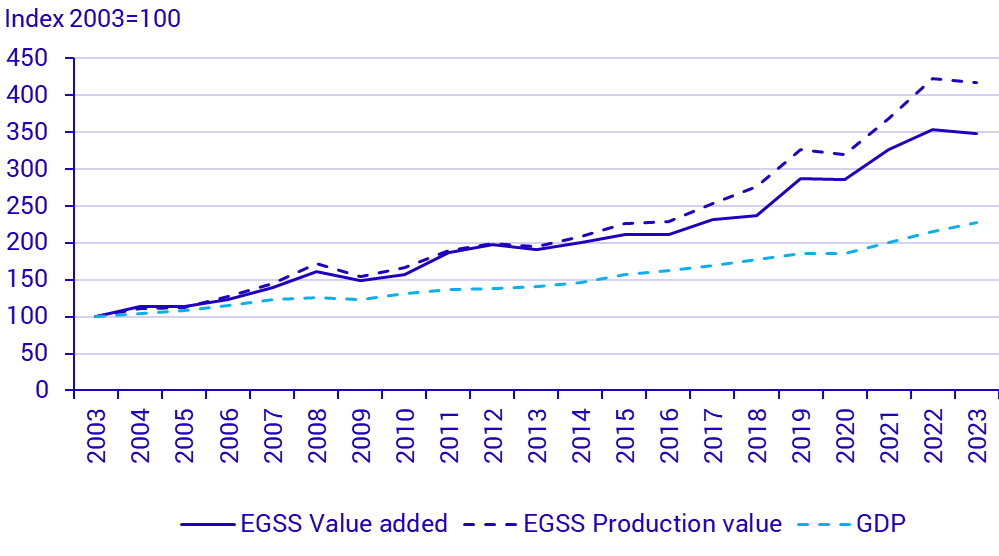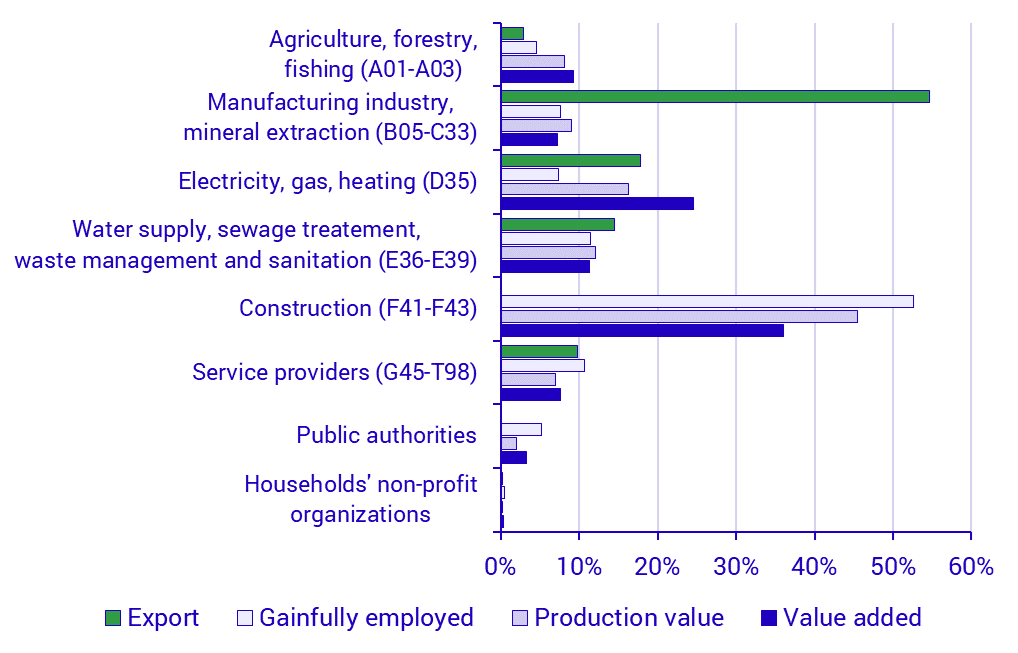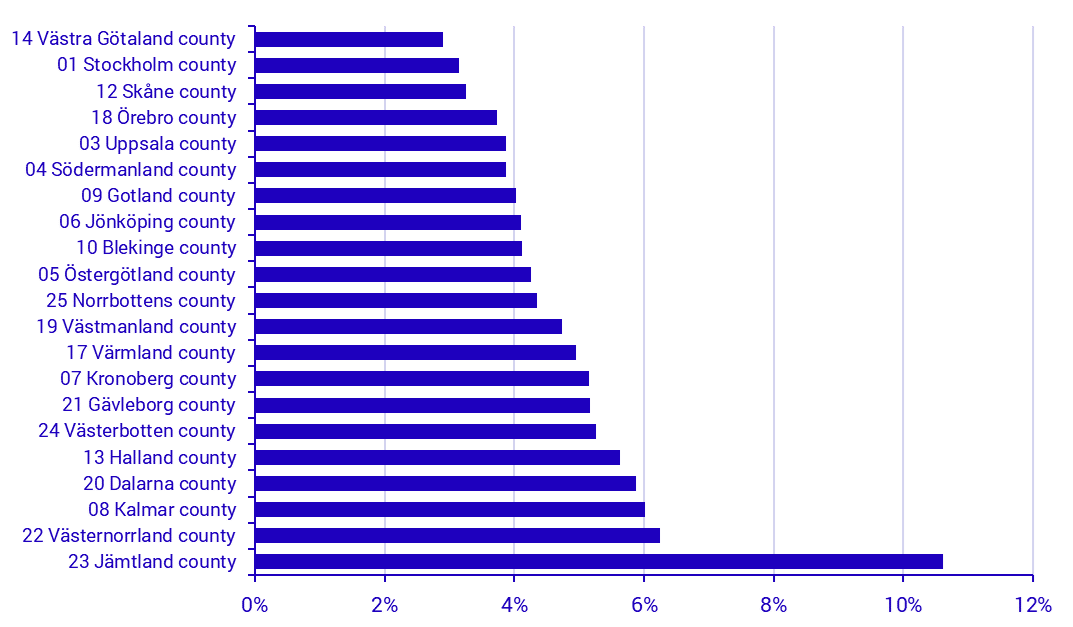Environmental Goods and Services Sector (EGSS) 2023
Growth in the environmental sector slowed down in 2023
Statistical news from Statistics Sweden 2025-10-16 8.00
The environmental goods and services sector accounted for 3.8 percent of Sweden’s total GDP in 2023, a small decrease from 2022. Both total production and the number of people employed in the environmental sector declined in 2023. The sector employed 160 000 people total, 21 percent of whom are women.
Statistics on the environmental goods and services sector describe the part of Sweden’s economy that produces environmentally friendly goods and services. The environmental sector includes the production of goods and services for environmental protection and sustainable resource management.
The environmental sector's value added amounted to 233 billion SEK in 2023. This is a small decrease from 2022 when the value added was 237 billion SEK. The decrease was mainly driven by lower production among environmental companies in the construction industry and among producers of electricity and heat.
- Production in the environmental sector declined in 2023, following a steady increase during previous years, says Philip Krantz at Statistics Sweden.
The production of environmentally friendly goods and services, measured as production value, decreased in 2023 and amounted to 677 billion SEK in current prices. The corresponding value in 2022 was 687 billion SEK. Since 2003 the environmental sector’s share of Swedish GDP has increased steadily.

Source: Statistics Sweden, Environmental Accounts and National Accounts.
Manufacturing had the largest share of exports
The largest share of exports in environmental goods and services was in the manufacturing and mineral extraction industry. Exports in the electricity, gas and heating industry were also relatively high. The construction industry, on the other hand, had the largest share of total production in the environmental sector in 2023. Moreover, the majority of people employed in the environmental sector worked in the construction industry.

Source: Statistics Sweden, Environmental Accounts.
The environmental sector’s share of the economy was still largest in Jämtland county
Statistics on the environmental sector are also available per county. Metropolitan counties account for the highest total value added, production value and number of persons employed. However, when value added is normalised as share of the gross regional product (GRP), the result is different. The highest value added as share of GRP for the environmental sector is found in the counties of Jämtland, Västernorrland and Kalmar.

Source: Statistics Sweden, Environmental and National Accounts.
Definitions and explanations
Environmental accounts are organised using national accounts as a base to enable reporting on environmental statistics and economic statistics in a common system. The environmental accounts, which are a UN-based statistical standard, provide opportunities for analysing connections between the economy and the environment, in particular through the use of industries that are reported according to the Swedish Industrial Classification (SNI).
Statistics Sweden’s Environmental accounts
Statistics on the environmental sector form part of the environmental accounts framework. Since 2017, under the regulation on European environmental accounts, it is mandatory for EU Member States to report these statistics annually to Eurostat. However, Statistics Sweden has published statistics on dates earlier than this, where statistics are available as early as 2003. In connection with the publication in 2018, the statistics were revised to better align with new guidelines and to be more closely integrated with the national accounts. This also enables deeper national and international comparisons, such as the environmental sector’s contribution to the Swedish economy. In addition to the national accounts data, data on company finances is used to describe net turnover, data from BAS (Population by Labour market status) to describe gainful employment, and data from foreign trade statistics to describe exports.
Statistics on the environmental sector are based on a micro-database of companies and workplaces that produce environmentally friendly goods and services. However, a model approach is used for the agriculture (A01), the forest (A02) and the construction (F41-43). For agriculture, the statistics are based on organic farming. For forestry and logging, statistics on the environmental sector are based on certified forestry. For construction operations, statistics on the environmental sector are based on data on nearly-zero energy buildings.
The statistics follow Eurostat’s environmental sector handbook, which contains definitions of which economic activities and products are included in the environmental sector. Examples of economic activity included are production of renewable energy, wastewater treatment, waste management, sanitation, environmental consultants, and organic farming. Examples of economic activity not included are wholesale of waste products, nuclear power, and public transport.
To read more on definitions and delimitations, see Eurostat’s handbook:
Next publishing will be
The environmental sector up to reference year 2024 will be published during the fall of 2026.
Statistical Database
More information is available in the Statistical Database
Feel free to use the facts from this statistical news but remember to state Source: Statistics Sweden.
